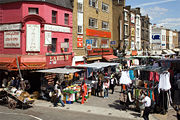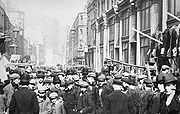
Petticoat Lane Market
Encyclopedia

East End of London
The East End of London, also known simply as the East End, is the area of London, England, United Kingdom, east of the medieval walled City of London and north of the River Thames. Although not defined by universally accepted formal boundaries, the River Lea can be considered another boundary...
.
The Modern Market
It is one of a number of traditional markets located to the east of the City of LondonCity of London
The City of London is a small area within Greater London, England. It is the historic core of London around which the modern conurbation grew and has held city status since time immemorial. The City’s boundaries have remained almost unchanged since the Middle Ages, and it is now only a tiny part of...
. A few hundred yards to the north is Old Spitalfields market
Old Spitalfields market
Old Spitalfields Market is a covered market in Spitalfields, just outside the City of London. It is in the London Borough of Tower Hamlets....
, which has been refurbished, and across Commercial Street, to the east, lies Brick Lane Market
Brick Lane Market
Brick Lane Market is a London market centred around Brick Lane, Tower Hamlets. It is located at the northern end of Brick Lane and along Cheshire Street in east London. It operates every Sunday from around 8am to 2pm....
. A half mile further east is the Columbia Road Flower market
Columbia Road market
Columbia Road Flower Market is one of many markets in Central London; a street flower market, it is located in East London. Columbia Road is a road of Victorian shops off the Hackney Road in the London Borough of Tower Hamlets...
. Petticoat Lane Market was not formally recognised until an Act of Parliament
Act of Parliament
An Act of Parliament is a statute enacted as primary legislation by a national or sub-national parliament. In the Republic of Ireland the term Act of the Oireachtas is used, and in the United States the term Act of Congress is used.In Commonwealth countries, the term is used both in a narrow...
in 1936, but its long history as an informal market makes it possibly one of the oldest surviving market
Market
A market is one of many varieties of systems, institutions, procedures, social relations and infrastructures whereby parties engage in exchange. While parties may exchange goods and services by barter, most markets rely on sellers offering their goods or services in exchange for money from buyers...
s in Britain.
The market is open Monday to Friday on Wentworth Street; on Sunday it extends over many of the surrounding streets, with over a thousand stalls. It is closed on Saturday, and on Sunday closes at about 2 pm. The markets are well signed from local stations. Despite its fame and history, Petticoat Lane market is not designed as a tourist attraction.
History of the market
In Tudor times, Middlesex Street was known as Hogs Lane, a pleasant lane lined by hedgerows and elms. It is thought city bakers were allowed to keep pigs in the lane, outside the city wall; or possibly that it was an ancient drovingDroving
Droving is the practice of moving livestock over large distances by walking them "on the hoof".Droving stock to market, usually on foot and often with the aid of dogs, has a very long history in the old world...
trail. The lane's rural nature changed, and by 1590, country cottages stood by the city walls. By 1608, it had become a commercial district where second hand clothes and bric-a-brac were sold and exchanged, known as 'Peticote Lane'. This was also where the Spanish ambassador had his house, and the area attracted many Spaniards from the reign of James I
James I of England
James VI and I was King of Scots as James VI from 24 July 1567 and King of England and Ireland as James I from the union of the English and Scottish crowns on 24 March 1603...
. Peticote Lane was decimated in the Great Plague
Great Plague of London
The Great Plague was a massive outbreak of disease in the Kingdom of England that killed an estimated 100,000 people, 20% of London's population. The disease is identified as bubonic plague, an infection by the bacterium Yersinia pestis, transmitted through a flea vector...
of 1665; the rich fled, and London lost a fifth of its population.
Huguenots fleeing persecution arrived in numbers in the late 17th century; many settled in the area, and master weavers settled in the new town of Spitalfields
Spitalfields
Spitalfields is a former parish in the borough of Tower Hamlets, in the East End of London, near to Liverpool Street station and Brick Lane. The area straddles Commercial Street and is home to many markets, including the historic Old Spitalfields Market, founded in the 17th century, Sunday...
. The area already had an association with clothing, with dyeing
Dyeing
Dyeing is the process of adding color to textile products like fibers, yarns, and fabrics. Dyeing is normally done in a special solution containing dyes and particular chemical material. After dyeing, dye molecules have uncut Chemical bond with fiber molecules. The temperature and time controlling...
a local industry. The cloth was pegged out on hooks in the surrounding fields. These were known as tenterground
Tenterground
A tenterground or tenter ground was an area used for drying newly manufactured cloth after fulling. The wet cloth was hooked onto frames called tenters and stretched taut so that the cloth would dry flat and square....
s. From the mid-18th century, Petticoat Lane became a centre for manufacturing clothes. The market served the well-to-do in the City, selling new garments. About 1830, Peticote Lane's name changed to Middlesex Street, to record the boundary between Portsoken Ward, in the City of London
City of London
The City of London is a small area within Greater London, England. It is the historic core of London around which the modern conurbation grew and has held city status since time immemorial. The City’s boundaries have remained almost unchanged since the Middle Ages, and it is now only a tiny part of...
and Whitechapel
Whitechapel
Whitechapel is a built-up inner city district in the London Borough of Tower Hamlets, London, England. It is located east of Charing Cross and roughly bounded by the Bishopsgate thoroughfare on the west, Fashion Street on the north, Brady Street and Cavell Street on the east and The Highway on the...
, which coincided with the Lane. But, the old name continues to be associated with the area.

Blitz
-Armed conflict:*The Blitz, the German aerial attacks on Britain in WWII. The name Blitz was subsequently applied to many individual bombing campaigns or attacks.*Blitzkrieg, the "lightning war", a strategy of World War 2 Germany-People:...
and later German bombing of World War II
World War II
World War II, or the Second World War , was a global conflict lasting from 1939 to 1945, involving most of the world's nations—including all of the great powers—eventually forming two opposing military alliances: the Allies and the Axis...
, served to disperse the Jewish communities to new areas. The area around Middlesex Street suffered a decline. The market continued to prosper. Beginning in the 1970s, a new wave of immigration from India and east Asia restored the area's vitality - centred on nearby Brick Lane
Brick Lane
Brick Lane is a street in the London Borough of Tower Hamlets, in the East End of London. It runs from Swanfield Street in the northern part of Bethnal Green, crosses Bethnal Green Road, passes through Spitalfields and is linked to Whitechapel High Street to the south by the short stretch of...
. The first-generation immigrant, Jasbir Sokhal, ran a successful glove stall at the market from 1972 until his death in 2001.
The market was always unpopular with the authorities, as it was largely unregulated and in some senses, illegal. As recently as the 1930s, police cars and fire engines were driven down The Lane, with alarm bells ringing, to disrupt the market. The rights of the market were finally protected by Act of Parliament
Act of Parliament
An Act of Parliament is a statute enacted as primary legislation by a national or sub-national parliament. In the Republic of Ireland the term Act of the Oireachtas is used, and in the United States the term Act of Congress is used.In Commonwealth countries, the term is used both in a narrow...
in 1936. As late as the 1990s, if Christmas Day fell on a Sunday, many of the local Jewish traders would still assert their right to open on a Sunday. The market remains busy and vibrant, reflecting both its immigrant history and its continuing popularity with locals and tourists. 'The Lane' was always renowned for the 'patter' and showmanship of the market traders. Some, selling crockery, would pile an entire setting onto a large plate, and then send the lot, high into the air. Catching the construction on its way down was to demonstrate the skill of the vendor, and the robustness of the porcelain.
A prominent businessman, Alan Sugar
Alan Sugar
Alan Michael Sugar, Baron Sugar is a British entrepreneur, media personality and political advisor. From humble origins in the East End of London, Sugar now has an estimated fortune of £770m , and was ranked 89th in the Sunday Times Rich List 2011...
, got his start as a stall holder in the market.
Transport
- Aldgate East tube stationAldgate East tube stationAldgate East is a London Underground station located between Aldgate and Whitechapel in the London Borough of Tower Hamlets.The station is in Travelcard Zone 1...
- Aldgate tube stationAldgate tube stationAldgate tube station is a London Underground station located at Aldgate in the City of London.The station is on the Circle Line between Tower Hill and Liverpool Street. It is also the eastern terminus of the Metropolitan Line...
- Liverpool Street StationLiverpool Street stationLiverpool Street railway station, also known as London Liverpool Street or simply Liverpool Street, is both a central London railway terminus and a connected London Underground station in the north-eastern corner of the City of London, England...
- The area is well served by buses, on Bishopsgate and Aldgate and Whitechapel High Streets
- Parking restrictions apply, throughout the area, on all days of the week

